Points, Badges, and Leaderboards – Do they really work?
Over the past several years I’ve been playing around with different Gamification widgets and platforms to experiment with a Points, Badges, and Leaderboard (PBL) system for this blog.
Now, as I’ve described many times before, even though PBLs aren’t the greatest thing ever (my book day titled “Actionable Gamification – Beyond Points, Badges, and Leaderboards.” Go figure.), they have an important place in Gamification. What makes them particularly tricky is that, depending on how its designed, the PBL game can be encouraging or insulting to users.
A Good PBL system can Engage the User
A good PBL game encourages the user to engage and dive deeper into content, seek out relevant information, and connect with and ultimately return to the host site (i.e., like my blog).
Take Khan Academy for an example. Their ‘Learning Dashboard’ entices users to take a series of lessons on a range of topics, gaining skill progress points, and achievement awards for completing challenges, while amassing energy points for having watched tutorials and completed quizzes. All of these mechanics ultimately encourages the user to learn math, science, etc.
My goal is similar: educate and engage users on human-focused design and gamification techniques. To transform a regular visitor into a bona fide gamification aficionado takes some time. A well designed PBL game would certainly add some cachet for the visitor to keep on reading my articles, watching my videos, and engaging in conversation with yours truly (something I definitely take a lot of enjoyment in and garners many PBL points).
Why I Chose the Captain Up Platform
And so, after having looked into various PBL platforms, I finally settled on Captain Up, an Israeli startup that rewards users for exploring your site and sharing it with your friends. Using a customizable selection of badges and point awards, the platform tracks which users are engaging most within the community and broadcasts their standing via a leadership board.
Why did I choose Captain Up over other alternatives?
Well, on top of having nifty designs, they have a lot of things I can customize – levels, points, achievements, and actions. I can even reward people for interacting with specific elements on any page- a very important mechanism as I seek to draw visitors’ attention to my Octalysis Framework and tutorial vids (both of which provide a solid grounding in the core drives and mechanics of Gamification).
As a gamification designer, I really like to customize my own system, instead of an out-of-the-box-no-tweaking system. I can even create new badges or levels based on images I upload myself!
I’ve been experimenting with different game design concepts and ideas these past few months, and so far, the most recent PBL design (found on the right hand side of the page) has been working very well with a test group of a couple hundred readers signed up to play and are now regularly engaging in my site’s content.
Dangers of a Gamified PBL System: Intrinsic vs Extrinsic Motivation
Since the topic of Intrinsic and Extrinsic motivation is one of the most common ones in the field, I won’t go into too much detail about them. But basically, the risk of many PBLs systems is that it shifts motivation from Intrinsic (I want to learn about Octalysis and other great gamification content!) to Extrinsic (I want to level up and earn that badge!).
Eventually, people could be doing it just for the points, and whereas they would love to read more about gamification to begin with, if I suddenly removed the PBL system that they are attached to, they might lose interest of reading this content altogether.
There are many ways to prevent something like that from happening, but there are thousands of ways to get it wrong – which is what many companies don’t understand right now.
How to Design an Engaging Game
The default setting rewarded a few points for watching a video and commenting on my blog posts, and a lot more for tweeting and sharing the post on Facebook. The platform is generally sound, especially since I indeed get more value when my readers are sharing my content to others. However, I felt the default points/rewards economy was not optimized.
The first thing I changed, was making commenting on my blog worth 100 points, and watching a video worth 40 points. Facebook Liking and Tweeting were only worth 25 and 10 points.
When I changed my system around, the kind folks in Captain Up asked me, “Isn’t 100 points way too much for just commenting?”
Good question.
Communicating a Game Worth Playing
During the Discovery and Onboarding Phases of a Player’s Journey (the beginning two phases) the first thing you want to communicate to users is whether this is “a game worth playing?”
With the rules you set, you are establishing an interaction with the user and communicating your values.
If you give people a bunch of points just to do marketing for you, or reward them virtual items for every little stupid thing, users will feel like the game is shallow – this is not a game worth playing. Users have no interest in a game if they know the game designer is just trying to benefit himself instead of caring about his users.
For instance, if there are points, progress bars, and badges for “How much money you donated to the site owner,” people will feel insulted by your lame attempt to use them for solely personal gains.
People know that sharing on Twitter/Facebook mostly benefits me, and so I don’t want to tell them that my game is about sharing. When I state that commenting on my site is worth more than anything else, I’m expressing that I value interacting *with you* more than anything else. I want to communicate with you, and that is what I value.
And if you don’t want to talk to me, at least watch my videos so you can learn something! And of course, if you are willing to share my content with your friends and family, I would be very grateful too, but I’m not going to use that as a large carrot in my site.
This tells users that the key of this game is “engagement.” I want you to be engaged, learn a lot, and participate in a community. THIS becomes a game worth playing.
The Real Challenge of the Game
Once users decide that this is a game worth playing and decide to sign up, we enter the Scaffolding Phase. It’s not too long until users realize, that to truly excel at the game (how is it possible that people have tens of thousands of points?), you need to get the badges.
Badges are like bosses, and to obtain those badges, it requires some seriously commitment (like one of the badges is earned if you are consistently on my site every day for 2 months! Who does that right?) Also, this is where users understand that to really win against other people, they will still need to share on their Twitter and Facebook as much as they can. At this point, since they are already playing the game, this is not an absurd setting, as it is only directed towards the hardcore players who want to achieve a high status.
Of course, badges are earned in many different ways, including commenting with consistency and watching more videos, but whereas in the Onboarding Phase, sharing on Twitter and Facebook are somewhat dismissed as an afterthought, this is where people realize they need to take it seriously. Of course, if you are this much into the game, I believe you would genuinely be enjoying the content and would want to share with friends anyway.
Rewards: Earned Lunch vs Easter Eggs vs Drops
A little mystery goes a long way.
The default Captain Up system usually tells people exactly what needs to be done to earn the various badges, such as “Tweet 50 times to earn this badge!” This is a Fixed-Action Reward, which I also call the Earned Lunch (Game Technique #7).
There’s usually no problem with Earned Lunches, as it does motivate people who want to know exactly what they are striving for (Core Drive #6: Scarcity & Impatience).
However, again, given that many of the activities are benefiting the site owner (such as Yu-kai Chou – yes, I just addressed myself in third person), users might not like a carrot that is blatantly telling them to “share my blog on Twitter 1000 times and you will earn this badge!!!”
As a result, I turn that into a game in itself with some Core Drive #7: Unpredictability & Curiosity.
On my site, the badge system is actually not fully advertised and transparent, and many lightweight users don’t even know about it.
But at one point in the Scaffolding phase, you will realize you unlocked a surprise badge that gave you a whopping 15000 points, and then you will think, “OK, how do I get the other badges?”
In my study of various types of Rewards, there are 6 main types of rewards, including Fixed-Action Rewards (Earned Lunch), and Random Rewards (Drops) (Game Technique #72), and Sudden Rewards (Easter Eggs) (Game Technique #30). Like I said, I don’t want the badges to be the big carrot as a “fixed-action reward,” but I very much prefer the Sudden Easter Egg Rewards, and sometimes even Random Drops.
Even though most of the points are awarded when you unlock badges, there’s not full transparency on how to earn them (a nice guessing game in itself), but there are certainly hints and clues throughout. Many of the clues lie in the actual description of the badge, as well as a progress bar that shows how close you are towards the goal, and you can correlate that to certain activities.
Why so Serious? Context and Playfulness
Another big mistake many PBL systems make is taking itself too seriously.
If you goes onto a site, and clicks a button, and suddenly, a message shows up that says, “CONGRATULATIONS!!! YOU JUST EARNED THE ‘I CLICKED ON MY FIRST BUTTON BADGE’!!!!You are a Superstar!! Click here to see all the other AWESOME BADGES you can earn!”
You’re not going to be excited. You’re going to be like, “Well, this is pretty lame. What else is there? A scrolling down badge? A click on the ‘about us page’ badge?”
Again, the context is all off, and the action does not match the outcome. As a result, users feel insulted. (The right way to do it is to only give them Achievement Symbols – trophies, stickers, badges, belts, uniforms – if they actually did something they feel they’ve accomplished themselves, going back to Core Drive #2).
So what I do on my system, is to generally be playful and not pretend that this PBL system is the best thing in the world. I do that with custom text and languages throughout the system.
For instance, the first time you did a Facebook Like on my blog, you will unlock the Like a Um Badge (referencing THIS video). Instead of saying, “You are the most awesome person in the world!!” the text reads, “Congratulations. You proved you can like something. You are not morbid.”
Again, just not taking things that seriously and being a bit playful. The user then knows that liking something is not that big of a deal, so you don’t need to insult them by saying they are masters of the Universe.
Even more directed to this trend, is my communication towards people who do Google +1’s on my blog. At the beginning, the text reads: “Oh yea. You know how to do a Google+. Good for you.” Then afterwards you can unlock a badge that reads, “Hmm, looks like you are doing more than just experimenting with Google+. Do you need a doctor?” to the What the Plus Badge, that reads, “Who uses Google+ that much anyway?”
However, towards the end, there’s a whopping 75,000 points badge (one of the worthiest on my site), that reads, “Alright. You have proven that you are a true Google+ Fan. You have earned my respect and I will no longer make fun of you for that.” It’s almost like a graduation and accomplishment for being persistent and sticking to what you believe in, despite other people making fun of you. I definitely respect and honor that.
Levels of Humor
I also did a lot of customized design for the levels. First of all, I changed the names of most of the levels (or rearranged the orders) to make them make more sense in my mind.
Of course, I add a lot of interesting communications that somewhat make fun of users (and myself) too. On Level 2, you achieve the status of Game-Curious. The description reads, “You are curious about gamification and ready to learn more. Of course, that has nothing to do with your sexual orientation.”
On Level 14, I uploaded a cool ninja image to become the Gamification Ninja level (anyone putting that on LinkedIn?). But at Level 15, you become a samurai, with a picture of Tom Cruise as a Samurai, and a description that says, “After regaining your honor as a Ninja, you now step back into the ranks of the Samurai…just like Tom Cruise.” (Reference: The Last Samurai).
Finally, towards the end, the most ultimate and highest level on my site is the status of Gamification Gosu, in which the text reads, “Congratulations. You have finally become a Gamification Gosu. Now you are just like me. In fact, I should become your apprentice and you can take over my cult.”
As you can see, none of it is designed to be taken THAT seriously, but is meant to install a sense of humor, some sarcasm, and a playful attitude, so the user knows that this is just a light-weighted system that’s not trying to butter them up in exchange of actions, but a system they can have fun, enjoy, and have a good laugh in.
This is somewhat like hanging out with your friends. If your friends gave you exaggerated gestures of how awesome you are no matter what you do, it’s pretty lame right? But true friends make fun of each other a lot in a playful manner, in which is more enjoyable than someone sucking up all the time. (There we have some Core Drive 4: Social Influence & Relatedness)
Rewards of My Gamification System
Now comes the other question – so what do people get when they are high level or achieved a special badge?
Well, first of all, none of that is very defined, and I purposely avoid something fixed – primarily because what I can offer may change in the future, and also I don’t want to shift things towards extrinsic motivation – people just clicking on my blog for the final reward.
I want people to genuinely be curious about interacting with my content, and simply use the system to keep track of their progress.
However, I do plan to provide A LOT of value to people who are high-scoring Octalysis Gamelites.
I regularly reach out to individuals who are high scorers on my blog via Facebook/Twitter and start to collaborate with them on different projects.
I’ve helped a couple of them with job referrals, and a few others to become contributors of my blog (with link-backs of their choice).
I’ve also given some top scorers exclusive workshops and/or recorded workshops that companies have paid thousands of dollars to access, as well as given free consulting/advice/shoutouts for my Octalysis Gamelites, which easily adds up to hundreds if not thousands of dollars of value too.
In the future, I’m continuing to come up with a variety of things I can do for my top scorers, including free access to my paid webinars/workshops, hiring them to my own company (I’ve actually started to pay some people for projects), showcase their work (or great personalities) in my videos, and ton more.
Basically, all the good SAPS stuff from Gabe Zichermann: Status, Access, Power, Stuff.
At the end of the day, if you are a high scoring Gamelite, that means you have been reading my content a lot, sharing with friends, and having a lot of conversations with me on my blog. With that in mind, I TRULY want to be your friend and appreciate all the time and effort you have spent on my site.
As a friend, I’m not dangling a carrot in front of you, but just helping you out with whatever I can with my resources, my network, my reach, and opportunities.
At the end of the day, this is just me try to keep track of who I should spend more time being friendly with, precisely because these people have already spent a lot of their own precious time on me. I want blog-reading to be meaningful on my site, and I’m not just getting more readers, but building true relationships here.
ROI Recognition
Another nice thing about Captain Up, is that you could see the ROI fairly easily/quickly.
Above is the monthly data from a while ago. This number has increased to 30,000+ visitors a month)
As you can see, even though people who participate in my Gamification program is only a small % of my users, they are driving a lot more behavior.
Only 1% of my regular traffic is tweeting my content, but a whopping 50% of Gamelites share on Twitter! Less than 1% of my traffic shares on Facebook, but 70% of Gamelites share there! (Not to mention the 59 Google +1’s that I make fun of 😉 )
More importantly for me (seriously), Octalysis Gamelite commented 170 times in the past month, whereas the rest of the folks only commented 48 times. And check this – on average a person who signed up as an Octalysis Gamelite has watched 6.8 videos! That’s quite impressive in terms of engagement!
Of course, it’s very likely that this is a correlation issue instead of a causation issue based on self selection, meaning only my best readers who already want to engage with me such as yourself (hint hint 😉 ) will sign up to my system in the first place. I’m sure that’s a large factor.
However, many of my users just sign up from curiosity (you could easily just stay at level 1 and never come back again), and it seems like the majority of them are pushing forward and becoming friends with me. I think I am convinced that if my readers participate in this program, there will be more engagement, more interactions with me, and more learning from my site. Something worth checking out.
Where You Come In
The first thing you should do, especially to understand all the dynamics that I have been describing on this post, is to signup and check it out yourself. After all, if you’ve already read this entire post, why would you NOT want to connect and start playing? 😉
Finally, as this will always be a work in progress, if you have any creative suggestions for improving the game, please leave a comment. Like everyone in this industry, I’m still learning everyday and making new experiments. If somehow you feel like this system is insulting you, is a bad method of turning intrinsic motivation into extrinsic, or anything else, let me know, and I shall be edified.


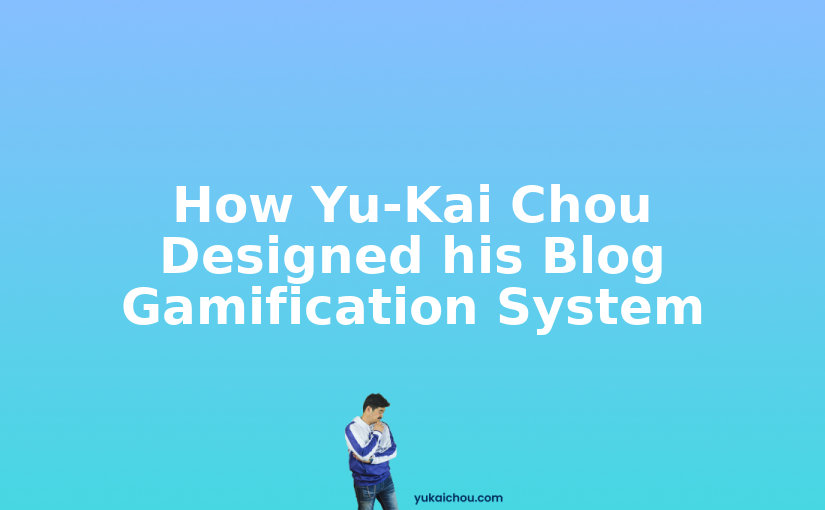
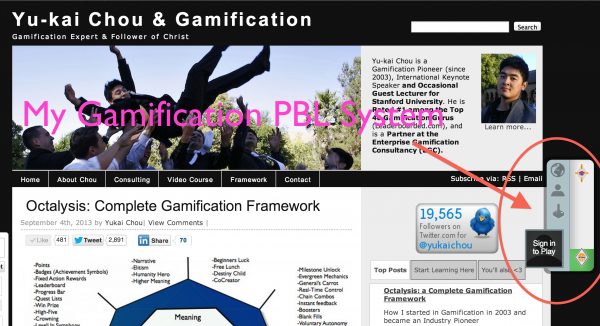

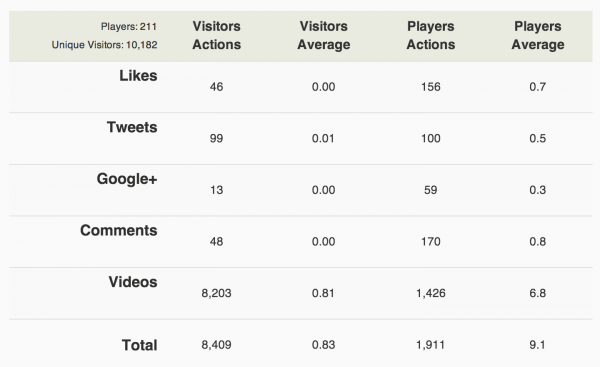

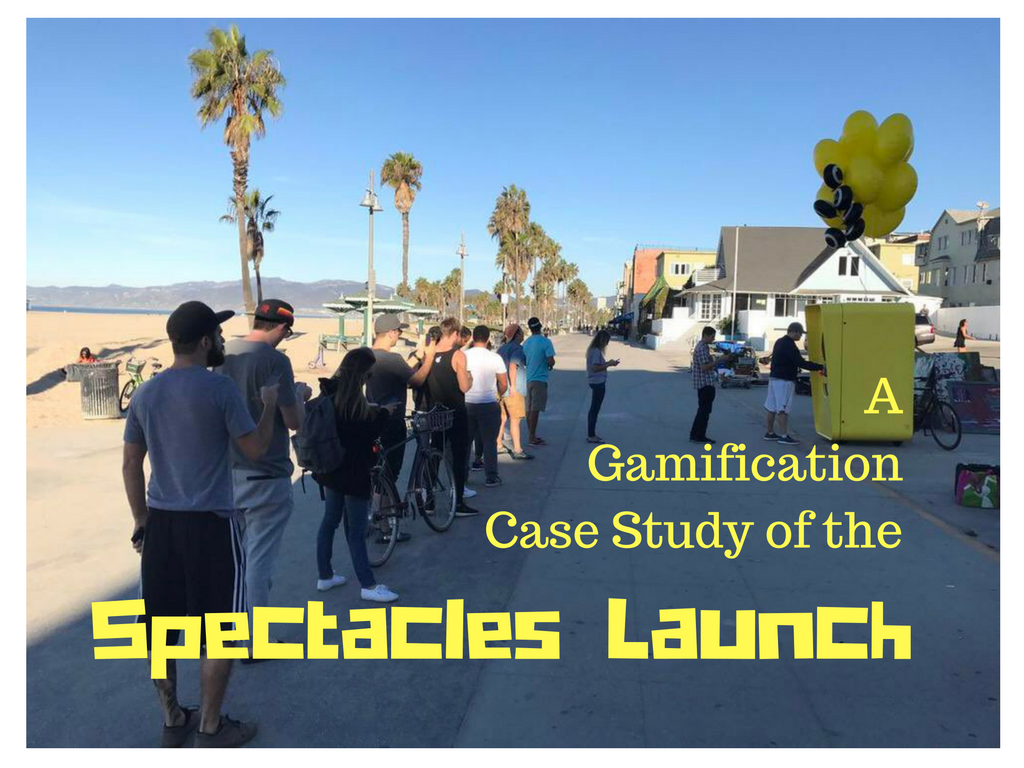

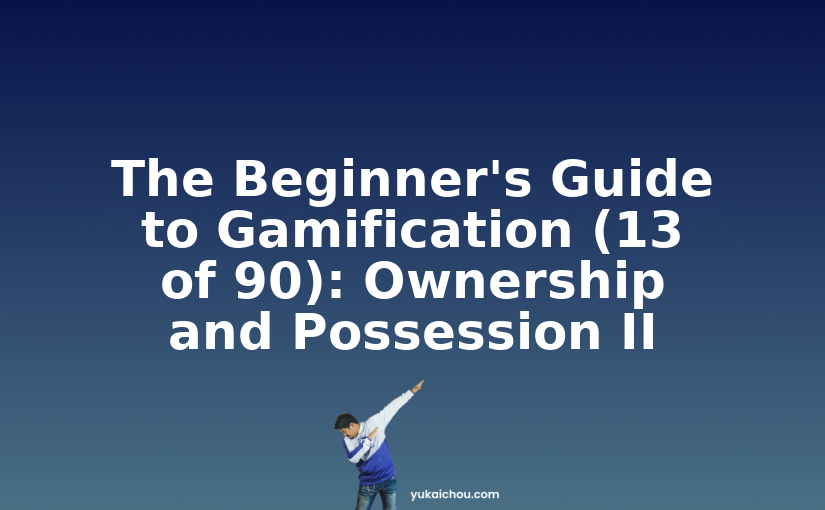
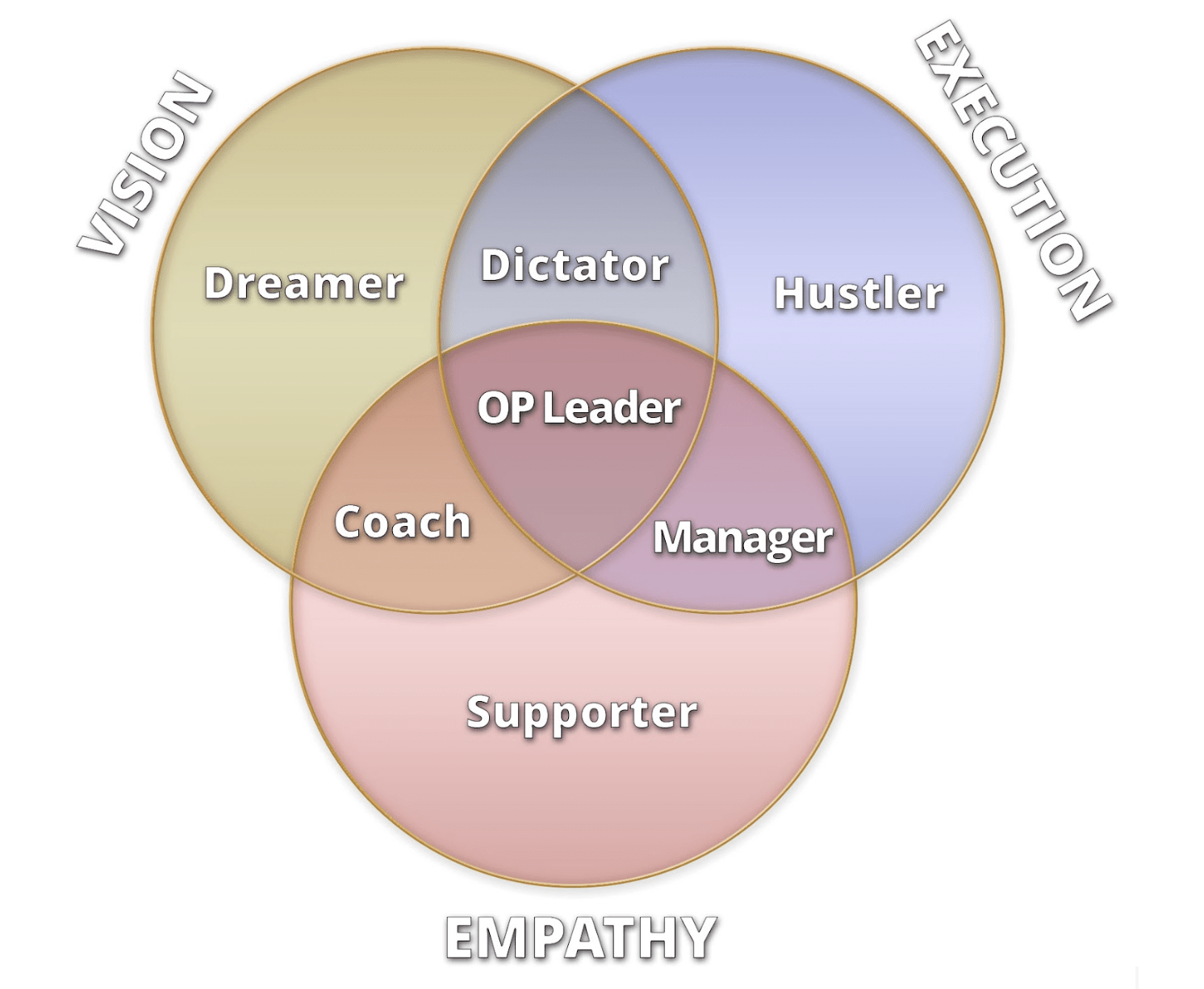
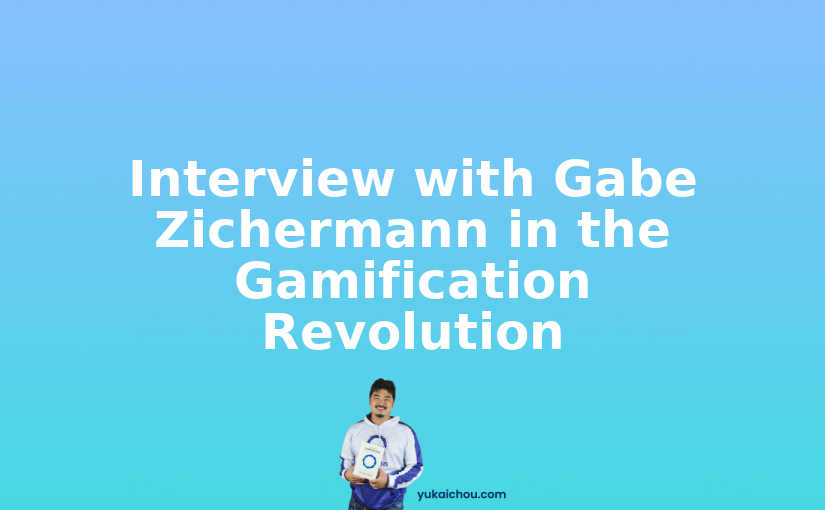
49 responses to “How Yu-Kai Chou Designed his Blog Gamification System”
“i was like um” Reading this post and appreciateing that you share Your Insight and experiance with gamification Yu Kai!
Thanks! 🙂
You really make sense and things meaningful Yu-Kai and that is indeed a great gift you have! You are indeed making a difference in the lives of people by sharing your passion of gamification for others to be guided and enlightened by the concept.
Continue doing what your doing and stay cool always!
All the best,
Ryan Cruz
Great advice. I do agree that you have to make the game meaningful. The overall results must be that the visitor must find as much interest in your site as they do the game.
I want offer some form of “value added” reward for high scorers. Problem is, i do not know how to incorporate this into the existing Captain Up system.
robpenner Haha, yes and you have been commenting a lot since!
Larus_Yang Haha, appreciate it Larus!
@mariano Thanks Mariano!
Thanks for the information real usefull!
I am engaging with all your posts?
Yu-kai Chou but you prefer Captain Up for this blog rather than BigDoor?
FrederikAggeRonex Agreed the update has been well received by many website owners.
It seems like my comments are getting credited now by the gamification system.
Hello, I was wondering what your consideration for mobile was when choosing this system?
I ask as I have recently been moving around a lot more and tried to access your content on both a tablet (although not the greatest) and my phone.
I got many issues with your site when trying to interact with it, from pages not loading properly, to a reload of the videos (As they are scored I assume) [Which on mobile was rather expensive, Especially in South Africa] …
I was really just interested in your thoughts and considerations of designing for mobile first – considering the world wide move to mobile devices as their first point of access to web content?
RichWallace Thanks for the comment Rich. It means a lot to me.
Actually, coming back to my blog a lot does give out more points, but it’s not explicit (nor are the points very high). I can probably adjust a bit of that though if I had time….being pinned down lately ;-(
Hi Yu-Kai, Thanks for taking the time to explain. It really helps my own thought process for the project I am working on which will include PBLs amongst other mechanics. I have found that the balance you have built, coupled with your amazing quest to share your knowledge has created a very engaging experience for me perosnally.
Not only do I want to master Octalysis but the PBL elements keep me coming back just to get a few more points or see if I can creep up the leadernoard. It’s a great journey.
I get the point (pun somewhat intended) of focusing on comments as the most value you see of the site (through interaction). Unless I have missed something I think it would be awesome to reward those who do spend the time to read the post but to spend the their time on the related videos as well as posting to be valued even more so 😉
Have Fun!
Rich.
Yes!
Captain Up has now fixed my issue with their service and I now once again receive points for commenting, sharing on Google+ and Twitter 😀
Yu-kai Chou mysocialface b
helmet_remover Sounds great – when can I expect to see new awesome features from your platform?
MayCat You are welcome! (Even you though you were thanking Captain Up :P). I’m glad my post helped you on some topics! 😀
Lucky that I read this post before I start balancing my PBL & rewards system, thanks a lot for this. It’s brilliant when you said about giving people more points for interactions. I had no idea about it but now I know how to let users know the key is engagement.
And I should try to use your way of designing the badges. At first I just think that telling users what they need to do is necessary so that I can guide them to do what I want. But now, I realize that surprise is great to make them more curious about my site and also get their engagement. May be I will use them both so that I can earn something more.
I learnt many things from the Captain Up, very helpful & fantastic. It’s also easy to learn, to understand and to know what and how to run a platform. Thanks you very much Captain Up!
Hi Yu-kai,
This is Goldy, product @ captain up.
Thanks for the detailed review. We are currently working on some changes to the default game settings, as you mentioned. We have also built into our roadmap some new flexible methods for site-owners to evaluate and rate the actions that are more valuable for them, thus automatically creating badges with a proportional and meaningful scoring scheme.
Would love to be in touch with you and discuss anything!
(We can have a mutual “comment thing” going on – almost as fun as asynchronous gaming!)
AlfredoPrietoMa Haha nice! Keep it up with your Professor Blog! 😀
mysocialface Thanks! It’s oddly harder to do experiments like these when you are at the top of an industry….it feels like any mistake you make you will be letting people down, but at Ieast I’m continuing to learn and experiment.
another brilliant article, you’ve nailed it again.
Yu-kai Chou Thank you! Yes I have seen BigDoor! very interactive.
Ashok Maharaj The biggest one is BigDoor. They are the one that G.co uses, and I like their product. The nice thing about their product is that it has one-click journeys that take you to various pages. Also, you can give real-live rewards based on points, such as “30 minute conversation with Gabe” or “Free book.” etc.
I like Kazooky’s sweepstake function (Core Drive #7), which would work pretty well.
Not a big fan of what I’ve seen in Punch Tab so far…
RubenGP Haha, just sharing my own journey 😉
Excellent write up! Thanks. Btw, what other PBL platforms are out there which are similar to Captain Up? I know Punch Tab and Kazooky….
Thanks Yu-kai Chou a good sample of “learning by doing” or it could be better to say “learning by playing” 😉
DanielHolmes Thanks Daniel! I’m glad this is a topic my readers care about. I thought instead of just talking about generic case studies, theories, or confidential client stuff, users would like to see how I think about designing something with each thought process. You can probably learn more from that.
Thanks for posting this article – I did really want to know how you put yours together….